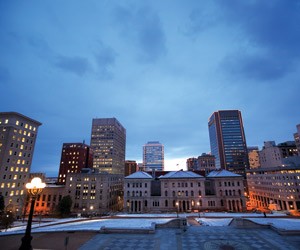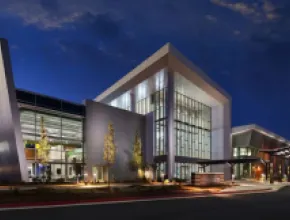The Old Dominion State is capitalizing on its role in the country’s evolution, as it commemorates the sesquicentennial of both the Civil War and Emancipation Proclamation with special events being held through 2015.
But the central and western areas of the state cater to more than history enthusiasts. The region has lakes and rolling hills, the Shenandoah Valley, the Blue Ridge Mountains, plus the Piedmont area between the sea and the mountains, all with a growing number of new and renovated places to gather and a thriving arts and culture scene.
Central Virginia
Richmond, the state capital and central region hub, has a capitol building designed by Thomas Jefferson that groups can see and a canal system developed by George Washington that groups can cruise. It serves up a walkable downtown with convention facilities and historical attractions and, also within city limits, white-water rafting on James River rapids.
Downtown attractions include the Richmond History Center, the Museum and White House of the Confederacy, and the Edgar Allen Poe Museum. Along the Canal Walk area is the American Civil War Center in the historic Tredegar foundry, a center of commemoration activities.
Jack Berry, president and CEO of the Richmond Metropolitan CVB, calls tourism “a turbo-charged economic engine.”
“Our hotels have experienced a double-digit percentage increase in sales and occupancy, outpacing not only other destinations within the Commonwealth, but across the country,” he says.
The Greater Richmond Convention Center has helped spark the resurgence of the Broad Street Corridor. It features 700,000 square feet of space, including a 30,550-square-foot ballroom and a 180,000-square-foot exhibition floor.
Connected by skywalk is the Richmond Marriott. Across from the center are the Hilton Garden Inn and the Richmond Coliseum. The $73.5 million Richmond CenterStage performing arts center is a block away.
“The Richmond region has a first-class facility, and is an attractive and affordable destination,” says Michael Meyers, general manager of the Greater Richmond Convention Center. “A busy spring made us optimistic that our business is on the upswing. Stalled development around the convention center is showing signs of activity.”
Near the center, the former Hotel John Marshall, which opened in 1929 and has been vacant since 1988, is now The Residences at John Marshall. It has a 4,800-square-foot ballroom and a 3,000-square-foot ballroom available for rent.
Last year, a 17,300-square-foot education center with meeting and event space was added to the Virginia War Memorial and included a remodeled outdoor amphitheater.
Downtown also boasts the Museum and White House of the Confederacy, which recently opened the $7.5 million Museum of the Confederacy–Appomattox, featuring event space.
Just 12 miles north, the IACC-certified Wyndham Virginia Crossings & Conference Center has more than 23,000 square feet of function space and recently finished upgrades to public space, meeting areas and technology. Guest rooms will be renovated next year.
Seventy miles northwest of Richmond in the Blue Ridge foothills, Charlottesville is home to Jefferson’s Monticello, University of Virginia (UVA) and Ash Lawn-Highland, the home of his friend James Monroe. To the north in Orange is James Madison’s Montpelier. All three presidents’ homes are open to the public and have event space.
In 2009, Monticello unveiled a new LEED Gold-certified, 42,000-square-foot visitor center and education center, and opened up space for private meetings and events for the first time. Last year, following a renovation, it added Montalto, a meetings-ready home once owned by Jefferson.
Top meetings properties include the Omni Charlottesville, the Doubletree Hotel Charlottesville and Keswick Hall. UVA’s facilities include the multipurpose John Paul Jones Arena.
Two miles west of Charlottesville is the University of Virginia Foundation’s 175-room Boar’s Head, with 22,000 square feet of meeting space. In April it completed a $9 million room renovation.
Virginia has more than 200 wineries and 16 wine trails—several located in the central and western areas. Donald Trump acquired Kluge Estate Winery near Monticello last year and renamed it Trump Winery. It has event space for more than 150 guests.
There is also a growing brewery scene.
“There can be few rural areas in the country with so many breweries and wineries in such a small area, and with better beer, better people, better wine and better views of the Blue Ridge,” says Dub Winkler, owner of Fardowners restaurant in Crozet, which keeps beer from three local breweries on tap, plus product from the wineries.
Devils Backbone Brewery at the southern end of the Brew Ridge Trail is a few miles from Wintergreen Resort on the Blue Ridge’s eastern slopes. The resort is being acquired by James C. Justice Companies Inc., owner of West Virginia’s legendary Greenbrier.
On the James River 70 miles southwest of Charlottesville, Lynchburg also lies in the Blue Ridge foothills.
“Lynchburg stands out as a meetings destination because of its central location, unique meeting facilities, outstanding accommodations, exquisite cuisine and Southern hospitality,” says Denise Scatliffe Jackson, sales manager at the Lynchburg Regional CVB.
Major meeting facilities include the Kirkley Hotel & Conference Center, the Hilton Garden Inn, the Craddock Terry Hotel and Event Center, the Holiday Inn Downtown, Liberty Mountain Conference Center and James River Conference Center.
Liberty University, founded by Jerry Falwell, has significantly expanded meeting space over the past two years.
Mariner’s Landing Resort and Conference Center at Smith Mountain Lake, 30 minutes away, has 7,500 square feet of meeting space, boating, a spa and 18 holes of golf.
In the southeast, Danville boasts the IACC-certified Dan River Institute Conference Center, with 20,000 square feet of meeting space
Western Virginia
On the other side of the Blue Ridge, the 200-mile Shenandoah Valley stretches from Winchester in the north to Roanoke in the south.
West of Charlottesville, the Stonewall Jackson Hotel in Staunton has almost 8,500 square feet of meeting space, and Blackfriars Theatre, a Shakespearean-era replica site, is connected to it.
Staunton attractions include the living history Frontier Culture Museum of Virginia and the Woodrow Wilson Presidential Library and Museum, which has event space.
Rockbridge County features the Natural Bridge Hotel & Conference Center, Washington and Lee University and the Virginia Military Institute.
“Natural Bridge is the place to be if you have a group visiting the Southern Shenandoah Valley. Available for guests are admission to the Natural Bridge of Virginia, the Butterfly Exhibit and the Monacan Indian Village,” says Mayumi Smitka, director of marketing at Lexington and Rockbridge Area Tourism.
West of Lexington at Hot Springs in the Allegheny Mountains is The Homestead, dating to 1766 and boasting 483 rooms, 72,000 square feet of meeting space, a spa, three championship golf courses, a downhill ski area and an equestrian center.
This summer the resort is completing the roll-out of a $25 million transformation, including a two-acre water attraction, a new spa and wellness center, new restaurants and bars, and a new mini-golf course.
“We have also just started offering off-road Segway tours on our trails,” says Lynn Swann, the resort’s director of marketing and communications.
Moving south, Roanoke is home to the Hotel Roanoke & Conference Center, an IACC-certified Doubletree Hotel with 63,000 square feet of meeting space.
Other meetings-ready properties include Sheraton Roanoke, Holiday Inn Roanoke Valley-View and Holiday Inn Tanglewood-Roanoke.
The Roanoke Civic Center and the Salem Civic Center are top group venues in the destination.
“Popular places for groups to see include downtown, the Virginia Museum of Transportation, the Taubman Museum of Art and the Blue Ridge Parkway,” says Catherine Fox, director of tourism and communications at the Roanoke Valley CVB.
Farther south, Blacksburg is home to Virginia Tech and The Inn at Virginia Tech & Skelton Conference Center. Managed by Houston-based Benchmark Hospitality International since last year, the IACC-certified property has 147 rooms and 24,000 square feet of conference space.
Slated to open in fall 2013 is the $94 million, 147,000-square-foot Center for the Arts at Virginia Tech.
Farther southwest, Abingdon is home to the Barter Theatre, the William King Museum and the Martha Hotel & Spa.
A new regional gateway attraction in Abingdon is the event-ready, 30,000-square-foot Heartwood, the Artisans Center, showcasing the art, music and food of southwest Virginia.
“Arts and culture play such an important role in Abingdon,” says Kevin Costello, director of tourism at the Abingdon CVB. “The opening of Heartwood and the synergy created by the art and cultural scene in Abingdon have really made it a destination.”
Bristol, where the main street straddles the Virginia-Tennessee line, features a historic downtown area and the Bristol Motor Speedway and Dragway, which hosts events such as the NASCAR Cup series.
Meetings-ready properties include the Holiday Inn Hotel & Suites- Bristol Convention Center, the restored Bristol Train Station, the new Foundation Event Facility and The Centre at Bristol.
Tony Bartlett has been writing about the travel industry for more than 25 years.






